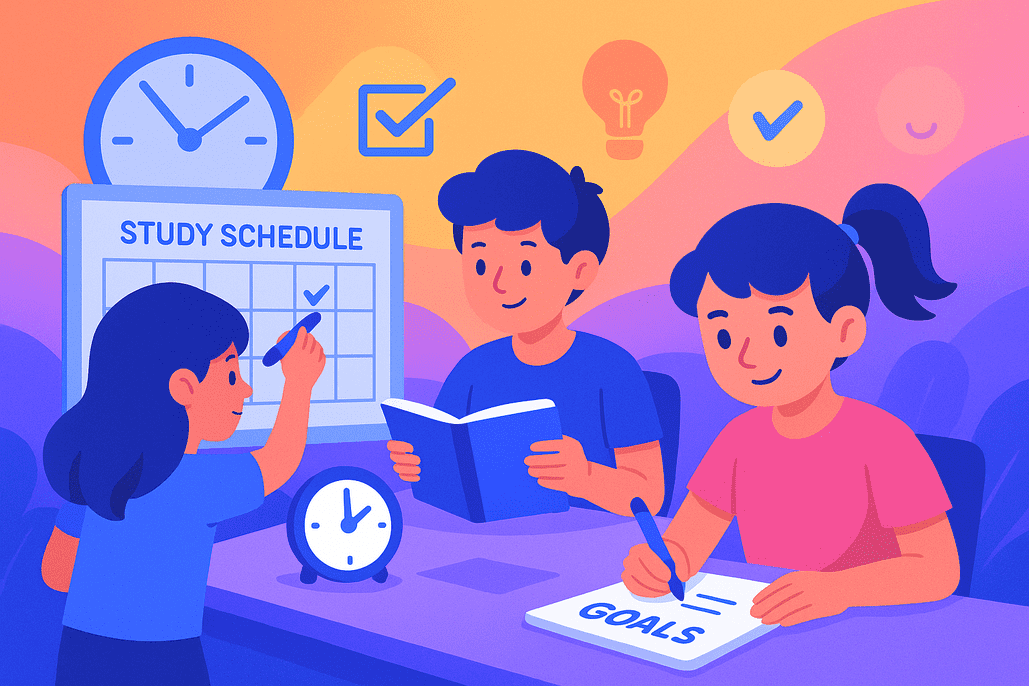Independent schools widely use the ACER Scholarship Test to identify students with strong academic potential, often across both primary and secondary entry points. It assesses reasoning, reading, writing and problem-solving under time pressure, with questions designed to be unfamiliar and to reward flexible thinking.Preparation that focuses on building these skills gradually tends to support better decision-making, pacing and confidence on the day.
This guide brings together practical strategies that go beyond the basics. It explains how to plan a preparation timeline, what to practise and why, how to use timed simulations effectively, and how to convert feedback into improvement.
It also shows where NotesEdu can help with structured ACER-style resources, including comprehensive practice tests, reading and writing programs, and an interview course aligned to common scholarship processes. For official program details, test dates, and participating schools, please visit the ACER Scholarship program page.
Understanding What ACER Really Tests
Higher-order reasoning over rote recall
At its core, the ACER Scholarship Test targets higher-order reasoning: analysing texts, inferring meaning, applying mathematics to unfamiliar contexts, recognising patterns, and expressing ideas clearly under time limits. It means “learning content” alone(for example, revising a set list of formulas or vocabulary) is only part of the picture. Students benefit when preparation develops transferable strategies, such as reading dense passages, choosing an approach for non-routine Math problems, and planning a concise written response quickly.
A practical lens for families
Think of the exam as four overlapping capabilities:
- Reading precision at speed — understanding argument structure, tone and implied meaning.
- Quantitative reasoning — modelling, estimating, interpreting data and checking probability.
- Pattern and abstract thinking — noticing rules efficiently and testing hypotheses.
- Written communication — turning ideas into a structured response under strict timing.
Preparation that systematically touches each capability builds both familiarity and resilience.
Map a Preparation Timeline You Can Actually Keep
Build months, not weeks
A realistic plan starts months out, even with short sessions. Two or three 30–45 minute blocks per week can be enough if they are focused and consistent. Early work should emphasise skill building (reading depth, vocabulary growth, core number sense), then progress towards full-length timed simulations in the final weeks.
Use simple milestones
- Weeks 1–4: Skill foundation. Reading breadth, core number routines, and sentence-to-paragraph writing.
- Weeks 5–8: Introduce ACER-style questions with short, timed sections; start error-log habits.
- Weeks 9–12: Regular mixed sets under time; one full simulation every 1–2 weeks.
- Final fortnight: Lighter volume; maintain one full simulation per week; prioritise sleep and routines.
A structured course make spacing easier. NotesEdu groups ACER resources by level and skill, allowing families to align weekly goals with the appropriate question sets and mock tests. Explore the ACER preparation catalogue fora one-stop view of programs and practice tests
Reading: Structure and Inference
Read across genres with a purpose
ACER passages can include argument, exposition, literature and persuasive pieces. Rotate non-fiction essays, feature articles, short stories and explanatory texts. For each passage, ask three things: What is the claim? How is it supported? What is implied rather than said? Practise summarising a paragraph in one precise sentence to sharpen understanding.
Drill with ACER-style comprehension
Targeted, exam-style reading practice closes the gap between broad reading and the specific demands of the test. NotesEdu offers the ACER Reading & Writing Course and ACER Scholarship-Style Reading Tests, which replicate passage length, complexity, and timing. These sets include explanations that show why an answer is correct, which is crucial for learning.
Tip: Create a “reading moves” checklist, like identify thesis, map paragraph roles, note shifts intone, predict before reading options and then answer.
Writing
Keep a compact response template
Over time, planning must be quick. Use a simple blueprint that works for most prompts:
- Position: one sentence answering the task directly.
- Reason 1 + brief example/evidence.
- Reason 2 + brief example/evidence.
- Counterpoint acknowledged in a line (shows balance).
- Conclude with a forward-looking insight.
Practise five-minute plans followed by 15–18 minute drafts. Focus on clarity, logical progression, and sentence control rather than ornate vocabulary.
Use targeted writing drills
Students improve the fastest when they receive specific feedback on topic adherence, paragraphing, sentence variety, and the precision of examples. NotesEdu’s Reading & Writing course includes detailed personalised feedback and guided prompts, helping students see what strong structure looks like (link above). For younger candidates, the Primary and Platinum programs step skills appropriately.
Maths and Abstract Reasoning
ACER Maths problems often reward modelling and estimation. Train your child to:
- Sketch a rough model first (table, number line, quick diagram).
- Estimate before calculating, and then compare the final result to the estimate.
- Use multiple approaches (ratio, unit rate, back-solving) and choose the fastest for the structure given.
- Run a “sanity check” for units, size, and sign (+/−).
Short daily number routines
Solving mental arithmetic problems, such as fractions, ratios, percentages, and scales, can pay off during timed sections. Add one puzzle each session that forces a choice of method rather than long computation.
Practise with mixed, exam-style sets
The NotesEdu ACER Scholarship Tests and ACER Platinum programs include mixed Maths and Abstract Reasoning sets under real timing, with worked solutions to compare methods (links above). Building a habit of error categorisation like misread, concept gap, or time that turns each practice into a lesson.
Timed Simulations: Build Pace Without Burning Out
Move from untimed accuracy to timed decision-making
Start new topics untimed to learn patterns and reasoning. Once accuracy is stable, introduce short timed blocks (e.g., 10–12 minutes) before attempting full-length simulations. This progression trains speed without sacrificing method quality.
Review is where the gains happen
After each timed set:
- Mark and group errors by cause.
- Rewrite one or two questions using a faster method or clearer plan.
- Note a rule or trigger (“If I see alternating sequences → test two-step rules first”).
- Log pacing data (questions completed, accuracy), then adjust your next target.
NotesEdu’s analytics in the ACER Scholarship Tests help students see time spent per item and accuracy by topic so that the next session targets what matters most.
Interview Preparation
Many schools pair the ACER test with an interview that explores curiosity, motivation, extra-curriculars and reflection. Students should prepare a short “map” of their interests, challenges they’ve tackled, and a piece of work they are proud of. Practise concise stories using a simple frame: Situation—Action—Result—Reflection.
NotesEdu’s Interview Course includes common themes, practice prompts, and delivery tips tailored to scholarship contexts.
Build a Feedback Loop
The error log
Keep a single document (or notebook) tracking:
- Question type and topic
- Why the error happened (rushed, misread, concept, strategy)
- Fix (new habit, cue, or method)
- One re-try of a similar item within 48 hours
It creates a personalised curriculum, cutting repetition of the same mistake.
Micro-goals and habit triggers
Swap vague goals (“do better at Reading”) for micro-goals (“five inference items in 10 minutes at 80%+”).Tie study to an existing routine: after dinner → 25 minutes of reading strategy drills.
Test-Day Systems
The 48-hour taper
Reduce volume and intensity two days before the event. Maintain one short mixed set to keep the rhythm, but prioritise sleep, hydration, and predictable routines. Skim a short“personal cues” list (e.g., “flag and move; estimate first; paragraph plan in 5lines”).
The first five minutes
- Breathe, scan the section rules, and mark the rough halfway time on your watch.
- Start with questions you can do cleanly to build early momentum.
- If stuck for more than a minute, flag and move to protect the easy marks.
After each section
Reset quickly. One grounding breath, one cue (“read stem twice”), continue.
Where NotesEdu Fits into a Balanced Plan
NotesEdu is used by many families to bring structure and realism to ACER preparation.The platform organises ACER resources by level and skill, provides timed practice, and includes explanations and analytics, allowing students to learn from each attempt.
Common Pitfalls (and Simple Fixes)
- Leaving it late → replace with a weekly rhythm of two short sessions plus one timed block.
- Pure content revision → balance with reasoning drills and reading strategy practice.
- Ignoring review → make an error log; revisit mistakes within 48 hours.
- Over-timing too soon → learn methods untimed first; add clock pressure later.
- Skipping writing practice → keep a compact response blueprint and rehearse fast planning.
A Sample Week (Stress-Light, Progress-Heavy)
- Mon (30–40 min): Reading strategy + two ACER-style passages (timed).
- Wed (30–40 min): Maths/Abstract mixed set untimed, then 10-minute speed round.
- Fri (30–40 min): Writing drill—5-minute plan + 15-minute draft; quick feedback checklist.
- Sun (45–60 min): ACER Scholarship Test simulation; log errors; set micro-goals.
Rotate course modules from the NotesEdu ACER hub to keep variety while staying aligned to the exam’s structure.
Conclusion
Preparing for the ACER Scholarship Test is a marathon of small, deliberate steps. Students benefit most from broad reading, reasoned problem-solving, clear writing under time, and calm routines. A plan that layers skill building with realistic, timed practice and turns mistakes into learning through targeted review creates genuine confidence. Families who prefer a structured pathway can utilise NotesEdu’s ACER programs to simulate test demands, gather valuable analytics, and prepare for interviews professionally and calmly.
Ready to bring structure and calm to ACER preparation? Explore NotesEdu’s ACER-style programs, timed tests and interview support to build skills step by step
Disclaimer
This article provides general information to help families plan ACER Scholarship Test preparation. No preparation method can guarantee a particular score or scholarship outcome. Performance depends on each student’s ability, effort and test-day conditions. NotesEdu is not affiliated with ACER. For official program details, refer to ACER’s website.
















